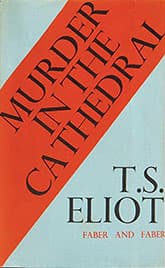Murder in the Cathedral
Critique • Quotes
 First edition
First editionFirst performance
1935, Canterbury, England
Literature form
Play
Genres
Tragedy
Writing language
English
Author's country
England
Length
Two acts plus interlude, approx. 16,000 words
Undramatic poetry
Murder in the Cathedral is not much of a play. Only two acts with an interlude—a sermon really—between them.
Not much stage action: England's archbishop, Thomas Becket, returns to the country in spite of the opposition of his former friend, King Henry, who wants the religious power wielded for his own political gains. Becket resists the temptation to capitulate and is slain by four knights, carrying out Henry's unspoken wishes.
It's written in irregularly metred verse, mostly four beats to the line, with sporadic rhyming. A chorus of Canterbury women moan and wail in the background, supposedly representing the hopes and fears of the common folk.
The characters of Eliot's most studied drama are not really individuals but representatives of positions in a moral argument. Becket, who ponders the nature of martyrdom and questions his own motives, is the only one who seems an individual, but he is too good for the real world. Apart from his momentary doubt over the "last temptation", he is too obviously venerated to be sympathetic to anyone who is not already an intense Christian.
The decadent material world
Despite the meditative tone to the whole work, the only point I find of intellectual interest is the possibility raised by Becket himself that even the desire to be a saint might itself be selfish.
Murder in the Cathedral is supposed to be the showcase of Eliot's attempt to revive poetic drama. But it comes across as less a work for the stage than a long dramatic poem, and even that's exaggerating the theatrical possibilities.
As for the verse itself, if you're familiar with Eliot's poetry you'll soon tire of finding the same images of decaying civilization and the impure material world here. Skulls, bones, rats, broken columns, the horror, the horror, ho hum. All leading to a pathetic prayer for divine mercy at the end.
It seems appropriate that the reactionary Eliot goes back to medieval times to find his religious inspiration.
For a number of years, Murder in the Cathedral was one of the few plays besides Shakespeare's taught in the schools. I understand it is no longer in such favour. For that mercy, students can give thanks.
— Eric
Critique • Quotes

